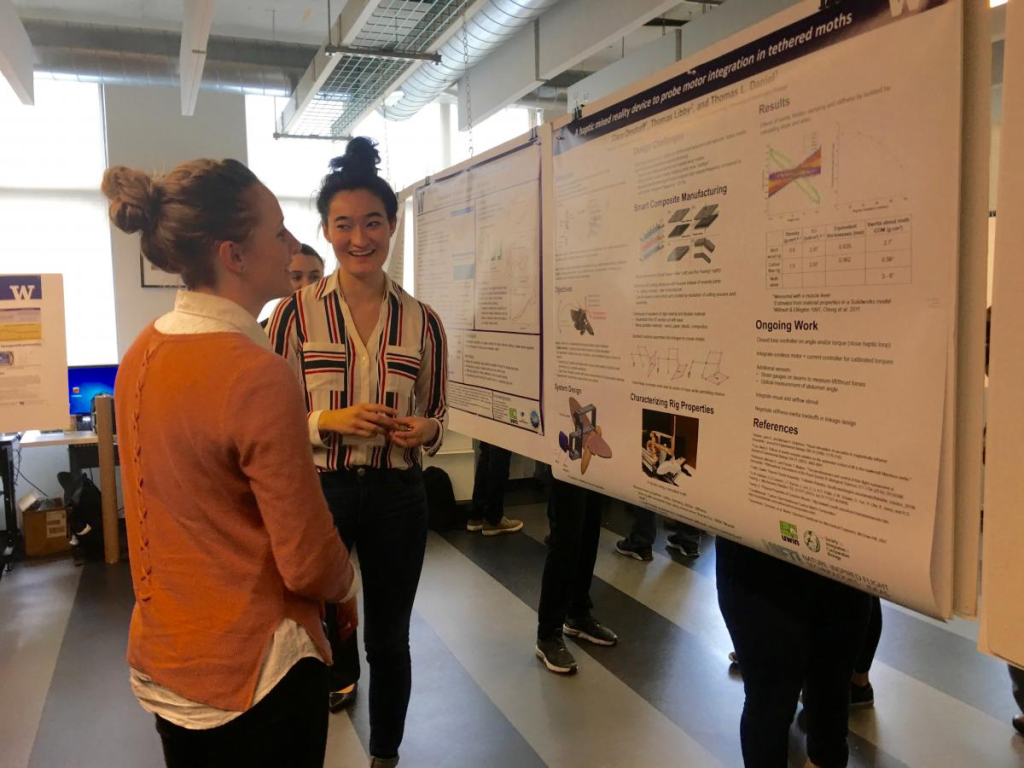
This two-day event, held at the CNT and the University of Washington Husky Union Building, brought students and world-class neural engineering researchers together to listen to, engage with and learn from each other.
In its eighth run, the Neural Computation and Engineering Connection, a two-day event from Jan. 24 to Jan. 25, did exactly what its title suggested: create an opportunity for researchers in neuroscience, computation and engineering to learn from each other’s’ work.
After a poster session in the Center for Neurotechnology (CNT), Adrienne Fairhall, CNT member and professor of Physiology and Biophysics at the University of Washington (UW), welcomed everyone and introduced the event. Fairhall explained how the event gathers the engineering community together from the UW Institute for Neuroengineering (UWIN), the UW Computational Neuroscience Center (UW-CNC), and the CNT.
After opening remarks, UWIN graduate fellows and UW-CNC graduate fellows gave 15-minute presentations about their current research, and the audience was able to ask questions and inquire about the future direction of the presenter’s work. The graduate students shared their engineering and neuroscience research on a range of topics such as how mice see the world, what patients with retinal prostheses see, and how to quantify human learning for clinical diagnosis.
“The best part of this event meeting is how seriously students were engaged,” said Eric Shea-Brown, a CNT member and professor in the UW Department of Applied Math. “The room is just as overflowing when first-year students give their two-minute research kickoff talks as for senior scientists giving overviews of their careers.”
Providing exposure to other researcher’s work
These talks were a way for attendees to envision the work they could do in the future or explore research related to their own projects. This was true for Adree Songco-Aguas, a post-baccalaureate researcher in the Rieke Lab who investigates the behavior of retinal ganglion cells when both rods and cones in the eye are active. She was particularly excited to see Iris Shi’s research on population coding in the visual cortex.
“Being here helps me put my research into context. Usually, I work on things on my own,” Songco-Aguas said. “Going to events like this helps me see where the work of neuroscience is going.”
Satpreet Singh is a graduate student in the UW Department of Electrical & Computer Engineering and researcher in the labs of CNT member, Bing Brunton, and CNT co-director, Rajesh Rao. Attending the presentations enabled him to learn more about the field of neuroscience as a whole and how his work fits in at the intersection of machine-learning, computer science, and neuroscience.
“It’s a place to find collaborations and insights to use in your own research,” Singh said. “I’m especially interested in the data and computational aspects of neuroscience, so I’m using these presentations to [identify] research questions that are amenable to the use of certain algorithms.”
The first day culminated in a discussion about ethics in neuroscience for researchers working at the intersection of neuroscience, computation, and engineering.
“My training is in applied math, not applied ethics or medicine, and I never thought I’d find myself on panel like this — debating issues that arise when brains can more and more directly interface with our own inventions,” Shea-Brown said. “We’re all part of the same research community now, and it’s the right move to get together and challenge one another through this conversation.”
Lectures by world-class leaders in neural engineering
Day one and two featured keynote presenters from the UW and other institutions. For example, day one featured a presentation from Andrea Behrman from the University of Louisville about the use of therapeutic inventions for children who are recovering after a spinal cord injury. For Singh, hearing researchers from across the country, like Behrman, was a great way to learn about the innovative work being done in neuroscience beyond the UW.
“Neuroscience is a large-scale effort,” Singh said. “It really does take many hundreds of labs to solve problems. Seeing work from other institutions adds to the range of work that you can discuss.”
To begin day two’s presentations in the Husky Union Building, Maryam Shanechi, an assistant professor at the University of Southern California, presented her work on developing new therapies for neuropsychiatric disorders and developing multiscale models of brain networks. She explained that 16 million people in the US. alone suffer from major depression and 33 percent are treatment resistant. Although some people have tried using seminal open loop electrical stimulation for depression, this treatment is not universally effective. The goal of her research is to improve the efficacy of this system by developing a mood-based closed-loop control. Throughout the presentation, people in the audience asked questions about how she removed noise in her electrocorticographic (ECoG) responses or what part of the brain is stimulated by electrodes in her experiments.
After Shanechi’s presentation, Andre Berndt, an assistant professor in UW Bioengineering, gave a talk titled “Advancing Neuroscience through Next-Generation Optical Tools.” His work focused on the use of genetically encoded sensors that record neural activity with cell-type specificity. Other keynote presentations from researchers at the UW and across the nation included Tom Libby’s presentation in modeling engineering machines after animal locomotion, Abby Person’s insights into the role of the cerebellum to motor control, and Mitra Hartmann’s research on using rat whiskers to study how movement and touch are combined in the brain to enable perception.
Ultimately, this event was an opportunity for researchers to share their projects and start conversations that could lead to potential collaborations. For this reason, the event ended with an open reception where attendees could discuss the project presentations and their own projects
“I think it’s exciting that there’s such a large community of people in this field. That’s one of the most exciting parts of this event,” Singh said. “It says something about how the UW is committed to growing this area of work.”
For more information about the 2019 Neural Computation and Engineering Connection, contact Adrienne Fairhall or Eric Shea-Brown.
